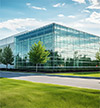Area Development (AD): Meaghan, thank you for taking the time to speak with us. Can you start by explaining your role and the scope of JLL’s Industrials Division?
Meaghan Elwell (ME): Of course. I’m the global Division President for JLL’s Industrials business. We manage all of the real estate needs for global occupier clients, including workplace management, design and construction management, site selection and transactions, lease administration, advisory services, occupancy planning, and more. We are organized by our clients’ business, which includes industries like manufacturing, automotive, oil & gas, utilities, rail, third-party logistics, airlines, airports, and aerospace. We manage everything from manufacturing plants and warehouses to office headquarters, airports, and distribution centers. Our team of more than 5,000 people manages over 800 million square feet of real estate, representing nearly $2 billion in managed spend.AD: What trends are you observing in site selection, particularly regarding workforce considerations?
ME: Workforce considerations are central to site selection. We’re seeing the emergence of industry hubs—clusters of manufacturing or logistics facilities—which create a talent ecosystem in a region. Skilled trades are especially in demand, so proximity to trade schools and specialized training programs is a key factor. Other factors like labor cost, transportation networks, and real estate availability are also critical. Manufacturers are focused on the cost of operations, and transportation, labor, and inventory are the three biggest cost drivers. Balancing these factors with workforce availability is key.
AD: How does JLL leverage artificial intelligence (AI) in site selection and real estate strategy?
ME: AI plays a significant role across the real estate lifecycle. In site selection, AI helps analyze variables like transportation costs, utility rates, workforce availability, market analysis, infrastructure assessment, and economic and incentive analysis. It also supports due diligence efforts by quickly sifting through large datasets to validate site characteristics. For lease agreements, AI abstracts data and identifies key terms more efficiently. Predictive AI is also being used for energy conservation and maintenance, enabling smarter building management. While AI accelerates analysis, it’s important to pair it with human expertise to verify insights.

AD: Quality-of-life factors are becoming increasingly important. How do they influence site selection?
ME: Quality-of-life factors such as affordability, safety, and social amenities play a big role in attracting and retaining talent. JLL’s recent survey indicates that while 88 percent of people like their home cities, only about 35 percent are likely to relocate within five years. For manufacturers, this means site selection must consider whether a location can support a stable workforce over the long term. Factors like trade schools, housing affordability, and safety are all critical to ensuring a location can attract and keep skilled workers.
AD: Infrastructure and accessibility are critical considerations. How do they weigh against labor costs and incentives?
ME: Infrastructure—including access to power, water, and transportation—is often a top priority. For manufacturers, energy and water availability often outweigh real estate costs, which typically represent only 5 percent of total operational expenses. Transportation accessibility is also key, especially for moving parts and products along the supply chain. Incentives can tip the scale when sites are otherwise equal, but they’re secondary to ensuring a site meets operational needs.
AD: Finally, how does JLL’s industry-specialized approach enhance the site selection process?
ME: Our industry specialization allows us to deeply understand our clients’ challenges and requirements. For example, we know the unique needs of battery plants or manufacturing facilities, which helps us deliver tailored solutions. We also foster peer networks among our clients, creating opportunities for collaboration and knowledge sharing in non-competitive environments. This approach not only enhances credibility but also ensures better outcomes in site selection and real estate strategy.


